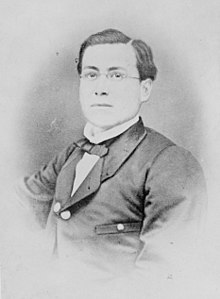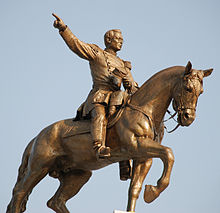Ignacio Zaragoza
![]()
The title of this article is ambiguous. For other meanings, see Ignacio Zaragoza (disambiguation).
![]()
This article or subsequent section is not sufficiently supported by evidence (e.g., anecdotal evidence). Information without sufficient evidence may be removed in the near future. Please help Wikipedia by researching the information and adding good supporting evidence.
Ignacio Seguín Zaragoza (born March 24, 1829; † September 8, 1862) was a general in the Mexican Army who became famous for his victory over French intervention forces at the Battle of Puebla on May 5, 1862 (the Cinco de Mayo).
Zaragoza was born in Presidio de la Bahía del Espíritu Santo in the then Mexican state of Coahuila y Tejas (now Goliad, Texas). His family moved first to Matamoros in 1834 and then to Monterrey in 1844. There the young Ignacio attended the seminary, which he left again in 1846. When war broke out with the United States, he wanted to volunteer for the Mexican army, but was rejected. Afterwards he worked for some time as a salesman of merchandise.
During the revolt against Antonio López de Santa Anna, Zaragoza joined the militia of Nuevo León in 1853 and was soon promoted to sergeant. When this was later incorporated into the regular army, he was given the rank of captain. He fought for the Liberals against Santa Anna's troops, including in the battles of Saltillo and Monterrey.
On January 21, 1857, his brother had to act as proxy at his wedding to Rafaela Padilla when Zaragoza was on an important mission for the army in San Luis Potosí. He and his wife later had four children, three of whom died in infancy.
During the Reform War of 1857-1861, Zaragoza again fought in all major engagements for the Liberals under the leadership of Benito Juárez, who had special confidence in him. Thus it came about that the latter, after the Civil War had been won, appointed Zaragoza Minister of War in April 1861. But already in October of the same year Zaragoza resigned from his new office to take over the command of the troops in the east - the French intervention in Mexico was imminent. In January 1862, his wife died.
Only a short time later Zaragoza had to concentrate on his task, for the French had landed an expeditionary force. He attacked the French at Acultzingo on April 28 and was repulsed. Zaragoza recognized Puebla's strategic value as a blocking position on the road to Mexico City and had it expanded for defense; in the position thus prepared, he defied General Lorencez's 6,000 French with only 4,000 poorly armed men in the Battle of Puebla.
After the battle was won, he informed President Juárez of his victory with a one-liner:
Las armas nacionales se han cubierto de gloria
(Meaning: "The nation's arms have covered themselves with glory") This saying later became so popular that it, along with Zaragoza's portrait, adorned the
Mexican 500 peso banknote between 1995 and 2000.
Despite the subsequent defeat at the hands of the French, whom he had pursued with his troops to Orizaba and who now repulsed his attack in their turn, the victory at Puebla lifted Mexican morale tremendously. In August he was ordered to Mexico City, where he was hailed as a hero in the streets. When he rejoined his troops in Puebla shortly thereafter, he contracted typhoid fever, from which he died on September 8, just 33 years old.
Benito Juárez was heartbroken at the loss of the able general and trusted comrade-in-arms; he ordered a state funeral and made Cinco de Mayo, the day of the victory at Puebla, a national holiday. The city itself was renamed from "Puebla de los Angeles" to "Puebla de Zaragoza."

Ignacio Zaragoza

Jesús Fructuoso Contreras: Monument to Ignacio Zaragoza
Search within the encyclopedia